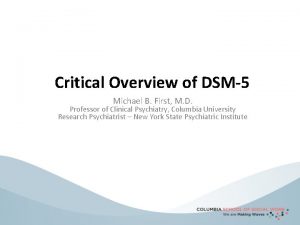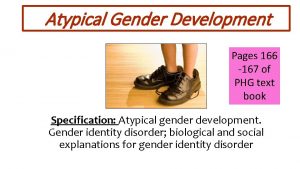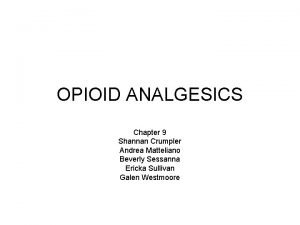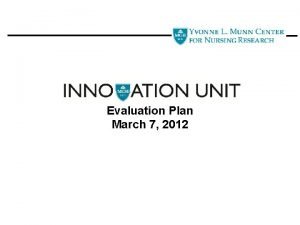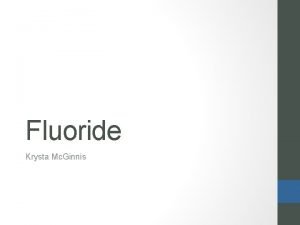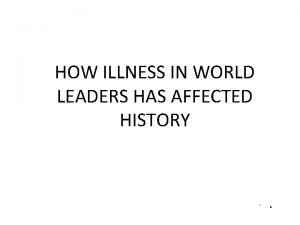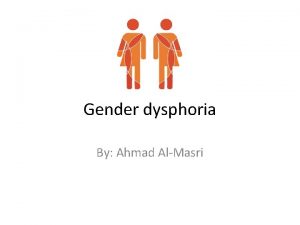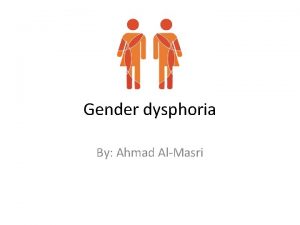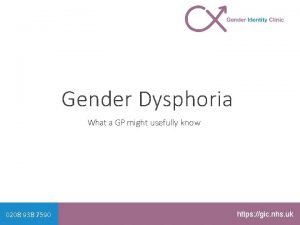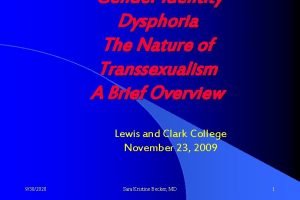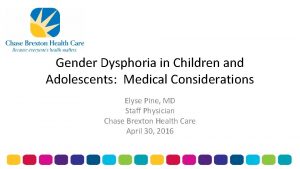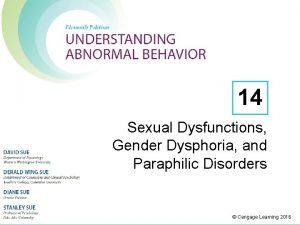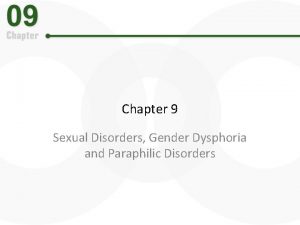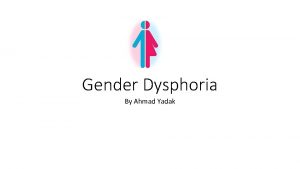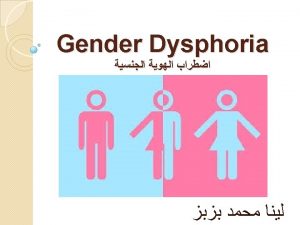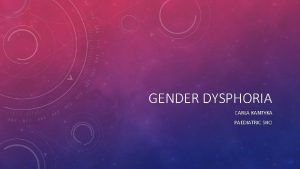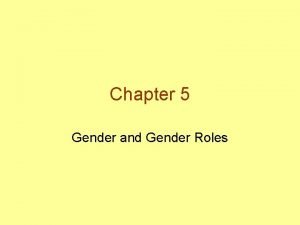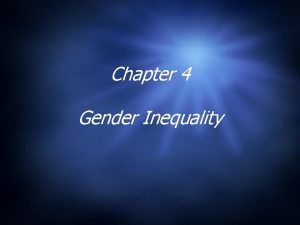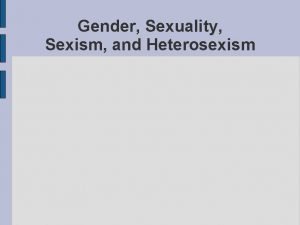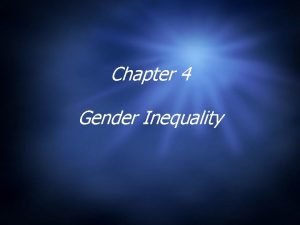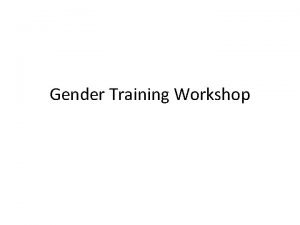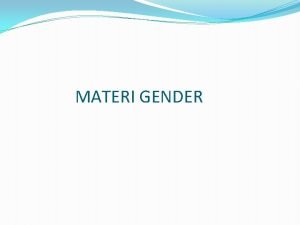GENDER DYSPHORIA 8 th March 2012 Dr Helen



















































- Slides: 51

GENDER DYSPHORIA 8 th March 2012 Dr Helen Greener Consultant Psychiatrist Northern Region Gender Dysphoria Team

• What are sex, gender and gender identity? • What makes us male or female? • What is gender dysphoria? • How do we manage gender dysphoria? • What are the consequences of gender change? • What treatments are available? • What should you know about the law?

Problematic Terms • SEX – The classification of an individual as male or female on the basis of anatomic, functional, hormonal, and chromosomal characteristics • GENDER – – Biological sex Personal, social or legal status “Psychological type” Can be based on body and behaviour, not on genital and/or erotic criteria

Binary Definition Of Gender Female Male

What is Gender Identity? • Self-defined and integral to personality • The inner conviction that one is male, female, neutral or ambivalent as distinguished from biological sex • Includes the person's sense of the body, dress, speech and mannerisms • One of the most basic aspects of self determination, dignity and freedom • Closely linked to gender role, which denotes a set of behavioural norms associated with a given gendered status in a given social group or system

Gender & Society • IN ALL SOCIETIES – There is a set of gender categories that can serve as the basis of the formation of a social identity in relation to others – Some individuals do not identify with the gender assigned to their biological sex • IN MOST SOCIETIES – A basic division between gender attributes assigned to males and females exists • IN SOME SOCIETIES – Membership of categories is open to people regardless of biological sex – “Third genders” exist – Surgical or hormonal treatment is employed to bring people's biological characteristics in line with their gender identity

Gender Role • Denotes a set of behavioural norms associated with a gendered status in a given social group or system • Culturally bound and fluid often depending on social and economic circumstances • There is significant variation between different cultures and eras

Sexual Dimorphism • Differences between the male and female sexes in size and appearance is seen in many animals • In humans men are generally larger, stronger and hairier while women have breasts, wider hips and a higher percentage body fat • However, the physical characteristics associated with one biological sex can often be seen in the other

Appearance • Appearance and gender presentation rely on much more than sexual dimorphism • We manipulate our appearance in many ways, in many cultures, for many reasons and have done so for millennia • What constitutes a feminine or masculine appearance is culturally bound and fluid • Clothes, make up, hair, surgery, piercings, scarification, gestures

Biology can be uncertain • Intersex & Intersexuality – States where an individuals sex chromosomes, genitalia, and/or secondary sex characteristics are neither exclusively male nor female • Includes – Non typical genital appearance (1 in 2000 births) – Chromosomal problems e. g. Klinefelter’s syndrome (1 in 500 male births) – Androgen insensitivity syndrome – Ovo-testes / “True Hermaphrodite”

What forms gender identity? • • • Social factors Genetic factors Prenatal hormone exposure Childhood experiences Socialisation Fundamentally the Nature Vs Nurture question is an open one

More “Problematic” Terms • • Transgendered • T-girl / T-boy Transsexual • Transvestite Transman • Agendered Transwoman • Bigendered Pangendered • Hermaphrodite Cross dresser • Intersex Drag King • Drag Queen Gender Nonconforming People

“Problems” with Gender Identity • Gender Dysphoria: unhappiness with one’s biological sex • “Concerns, uncertainties, and questions about gender identity persist during a person’s development, become so intense as to seem to be the most important aspect of a person's life, or prevent the establishment of a relatively unconflicted gender identity. ” • There are varying degrees of dissatisfaction • Controversy exists regards viewing the gender identity as problematic and the associated medicalisation of trans identities

Associated Difficulties • • • Depression & anxiety Other mental illness Suicidality Deliberate self harm Alcohol and substance misuse Educational under performance Crime – victim (transphobic) & perpetrator Personality disorders (? ) Intellectual disability (? ) Autistic spectrum disorders (? )

F 64. 0 Transsexualism • A desire to live and be accepted as a member of the opposite sex, usually accompanied by a sense of discomfort with, or inappropriateness of, one's anatomic sex, and a wish to have surgery and hormonal treatment to make one's body as congruent as possible with one's preferred sex • The transsexual identity has been present persistently for at least 2 years • The disorder is not a symptom of another mental disorder nor is it associated with chromosome abnormality

Other Categories. . . • ICD F 64. 8 Other gender identity disorders • ICD F 64. 9 Gender identity disorder, unspecified • ICD F 64. 1 Dual role Transvestitism • DSM-IV Gender Identity Disorder Where is the spectrum?

F 65. 1 Fetishistic transvestism • Disorder of sexual preference not gender identity • The goal is obtaining sexual excitement through creating the appearance of a person of the opposite sex • Clear association with sexual arousal • There is usually a strong desire to remove the clothing once orgasm occurs and sexual arousal declines • It can occur as an earlier phase in the development of transsexualism

All Change. . . • ICD 10 and DSM-IV are being rewritten • De-psychopathologisation • Conflicted gender identity or nonconformist identities no longer mental disorders • Is gender difference an inherent part of the normal spectrum of human experience? • Impact on access to care and treatment?

ANY QUESTIONS

MANAGING GENDER IDENTITY DISORDERS

Our Service • • • Assessment & Diagnosis Psychological & Psychosexual Therapy Speech Therapy Cross Gender Hormones Referral for other treatments, including surgery Coordinating / liaison role but not care coordination • Ongoing support and assessment

Assessment • Early life experiences • Gender – development, experiences, feelings • Sexual development and maturation • Sexuality • Relationships • Education & employment • • • Medical history Psychiatric history Social circumstances Spirituality and religion Body image Exploration of expectations, desires, needs • Mental state examination DIAGNOSIS • Important and leads management • Technically a medical task but input from others essential

Treatment Spectrum of Gender Dysphoria • The aim of treatment is – achieve lasting personal comfort with gender expression – maximize overall psychological well-being & self acceptance • Diverse group with diverse needs • Person-centred, within boundaries of limited evidence base and accepted treatment/guidance • May address underlying causes of gender distress • Unless the long term plan is full time gender change, physical treatments do not form part of treatment • Does not mean permanent gender change for all

Guidelines • WPATH Standards of Care – Provide professional guidance for psychiatric, psychological, medical, and surgical management – Minimum standards – Open to local interpretation and implementation – A new edition in the last 6 months • National guidelines – Aim to provide equivalent care across England – Consensus has not been reached • There is a paucity of evidence

The Real Life Experience (RLE) • Becoming an outdated concept • A commitment to the RLE has been considered essential for medical treatments in the past • A transperson is expected to live in their preferred gender role for a period of time before surgery • Allows time to realise the full and sometimes unexpected consequences of gender transition and demonstrates an ability to function • The intention is to reduce the incidence of post-treatment regret but evidence for this is lacking

Transitioning The Process of Changing Gender • • • Coming out to family, friends, employers Change of name socially and legally Asking others to use the appropriate pronouns Changing name and gender on official documents Adapting to changes in – Personal relationships – Sexual functioning • Bringing outward appearance in line with internal feelings – Clothing, jewellery, accessories, makeup, mannerisms – Hormones – Surgery • Changing voice’s pitch • Gender Recognition Certificate

Potential Negative Consequences • Relationships • Family • Health – Surgery / Hormones – Morbidity / Mortality • Education • Finances • Employment • • • Housing Access to Services Substance misuse Discrimination Crime – Victims – Perpetrators • Social Isolation

Transphobic Crime • 46% of trans people had experienced harassment in their neighbourhoods • 73% had experienced some form of harassment in public • Hate crime research has found that nearly a third of hate crimes occur outside the victim’s home and 20% of incidents involve neighbours

Potential Positive Consequences • • Relationships Family Health Psychological wellbeing • Education • Finances • Employment • • Sexual life Access to Services Substance misuse Acceptance Self expression Social activities Empowerment

Cross Gender Hormones • An individual must be living in their preferred gender role or intend to do so within the next 6 months (in our service) • We rely on general practitioners to prescribe the drugs and provide physical monitoring • The new international guidance supports hormones without changing gender

Important Considerations • • Off licence Irreversible consequences e. g. infertility Impact on physical health Safe in short to medium term but long term risks are unknown Few absolute contraindications Choice of product, dosage and method of delivery Informed consent Lack of research and data is often extrapolated from use in cisgendered people • Interactions • Alcohol intake, smoking, diet, obesity, drug use, prescribed medication

Estrogens • • • Weakening of beard and body hair growth, facilitating removal Reduction in the size of the genitals Erections and orgasm may be less readily achieved Reduced libido Breasts may feel tender and sometimes, but not always, increase modestly in size Redistribution of fat to a more feminine pattern Loss of muscle bulk and power Estrogens may have a calming effect Male-pattern baldness is arrested

Side Effects of Estrogens • • • Weight gain Nausea and vomiting Impaired liver function Increased risk of gallstones Depression Infertility Dry skin and brittle nails Headaches / migraines Decreased glucose tolerance

Serious Complications • • • Deep vein thrombosis Pulmonary embolism Cerebrovascular accident Heart disease Diabetes Hypertension Pulmonary embolism Oestrogen-related cancers Prolactinoma (extremely rare)

Testosterone • • Beard and body hair growth Male-pattern baldness Clitoromegaly Heightened libido Increased muscle bulk Irreversible deepening of the voice Cessation of menstruation (occasionally there is break-through bleeding requiring adjustment of the dosage)

Testosterone – Side Effects • • Polycythaemia /increased haematocrit Nausea /vomiting Abdominal pain Headaches /migraines Weight gain /Water retention Skin changes (rashes) /acne Infertility Altered lipids and clotting

Serious Complications • Increased cardiovascular risk due to decreased insulin sensitivity, increased blood pressure, altered lipid profiles • Endometrial hyperplasia, polycystic ovaries, gynaecological malignancy (? ) • Aggression • Exacerbation of obstructive sleep apnoea • Rarely liver tumours, breast cancer, osteoporosis, psychiatric disorders

Transwomen • Laser hair removal • Surgical Treatments – Breast augmentation – Tracheal shave /voice surgery – Genital surgery • Orchidectomy • Cosmetic vulvoplasty • Vaginoplasty – Facial surgery

Transmen • • • Mastectomy Hysterectomy Vaginectomy Testicular implants Metoidoplasty Phalloplasty

Gender Realignment Surgery • Assessment of eligibility and readiness • Second psychiatric opinion required • Not all transsexual people want to or can proceed with genital surgery • Not a vital aspect of gender transition • Often seen as an endpoint in research which is not helpful

Important Points • Many patients find comfortable, effective ways of living that do not involve all components • Some individuals cannot have some physical treatments • Not every patient requires psychotherapy in order to proceed with hormone therapy, gender transition or surgery • Other models of care exist • Transgender care in the UK may change a great deal in the coming months and years • We appreciate your support

ANY QUESTIONS

Gender Recognition Certificate • It allows a transperson to change their legal birth gender and “the person’s gender becomes for all purposes the acquired gender” – Marriage / civil partnerships – Retirement / pensions / benefits – Obtain a new birth certificate (in the UK) showing his or her legally recognised gender • “It is an offence for a person who has acquired protected information in an official capacity to disclose the information to any other person. ”

Changes to the law • The Gender Recognition Act was given Royal Assent in 2004 • The Sex Discrimination Act was amended in April 2008 to protect transsexual people against discrimination and harassment in the provision of goods, facilities and services • The Equality Act came into force on 1 October 2010 • “Working for Lesbian, Gay, Bisexual and Transgender Equality: Moving Forward” was published in March 2011

The Equality Act • The Equality Act simplifies, streamlines and strengthens the law – Eliminate unlawful discrimination, harassment and victimisation – Advance equality of opportunity between different groups – Foster good relations between different groups • It makes it easier for employers and companies to understand their responsibilities • It sets a new standard for those who provide public services to treat everyone, with dignity and respect • It covers equal pay, employment, schools, education, services, public functions and associations. . .

Public Sector Equality Duty • Created by the Equality Act 2010 and replaces the race, disability and gender equality duties (came into force in April 2011) • It covers age, disability, gender reassignment, pregnancy and maternity, race, religion or belief and sexual orientation • Any organisation which carries out a public function

Provision of goods and services • The law applies to both public and commercially run services and enterprises • It is unlawful for – a shopkeeper to refuse to serve a customer because they are intending to undergo, are undergoing or have undergone gender reassignment – a leisure centre to refuse to permit a transsexual person to use their facilities – a housing association to refuse to offer accommodation to a transsexual person, or to offer housing of lesser quality or on different terms

Exceptions • Religious organisations • In hospitals and establishments for persons requiring special care and attention it may also be permissible to take a less favourable approach towards transsexual people provided that to do so is a proportionate means of achieving a legitimate aim • Similar limited exceptions are applicable to charities and communal accommodation

Relevant Guidance • Equality Act 2010 Code of Practice - Services, public functions and associations Statutory Code of Practice http: //www. equalityhumanrights. com/uploaded_files/Equality. Act/servicescod e. pdf • Provision of goods, services and facilities for trans people - Guidance for public authorities: meeting your equality duties and human rights obligations http: //www. equalityhumanrights. com/uploaded_files/PSD/psd_trans_guidan ce. pdf • Public Sector Equality Duty http: //www. equalityhumanrights. com/advice-and-guidance/public-sectorequality-duty/

ANY QUESTIONS

Gender Dysphoria Service • Poplars Annexe Cherry Knowle Hospital Ryhope Sunderland SR 2 0 NB • Tel 0191 5667170 • Referrals must include full medical and psychiatric history • GP must agree to referral
 Dsm v sexual disorders
Dsm v sexual disorders Gender dysphoria biological explanations
Gender dysphoria biological explanations Andrea matteliano
Andrea matteliano Rejection sensitive dysphoria
Rejection sensitive dysphoria March march dabrowski
March march dabrowski Helen midtown computer solutions helen speaking
Helen midtown computer solutions helen speaking Midtown computer solutions helen speaking
Midtown computer solutions helen speaking March 7, 2012
March 7, 2012 Strategic gender needs and practical gender needs
Strategic gender needs and practical gender needs Happy wednesday march
Happy wednesday march 1965 march
1965 march Celebrated on march 17
Celebrated on march 17 March madness banner
March madness banner 535 before 14 march
535 before 14 march Welcome to english
Welcome to english Death march edward yourdon
Death march edward yourdon Wasserstand march hohenau
Wasserstand march hohenau Sherman's march to the sea
Sherman's march to the sea Example of critical essay
Example of critical essay 1965 march
1965 march Path of sherman's march to the sea
Path of sherman's march to the sea March 14 1879
March 14 1879 Ides of march punic wars
Ides of march punic wars Where was van gogh born
Where was van gogh born Geogrphic
Geogrphic Media blasting march
Media blasting march 21 march equinox
21 march equinox Chapter 15 section 4 aggressors invade nations
Chapter 15 section 4 aggressors invade nations Macro environnement marketing
Macro environnement marketing Glasgow 5th march 1971
Glasgow 5th march 1971 23 march 1996
23 march 1996 January february march april may
January february march april may Glasgow 5 march 1971
Glasgow 5 march 1971 March 2013
March 2013 Sherman's march significance
Sherman's march significance Cscape envisionrv
Cscape envisionrv March identifier clips
March identifier clips Slice march
Slice march Astronomy picture of the day march 29 2006
Astronomy picture of the day march 29 2006 Performance art
Performance art Poem for 8 march
Poem for 8 march March 30 1981
March 30 1981 March 5 2021
March 5 2021 Genetic engineering conclusion
Genetic engineering conclusion March 25 2011
March 25 2011 Path of sherman's march to the sea
Path of sherman's march to the sea Someone is taking someone for a walk cartoon
Someone is taking someone for a walk cartoon A peep under the iron curtain
A peep under the iron curtain Salt march
Salt march Ohio become a state
Ohio become a state 3 major battles of the texas revolution
3 major battles of the texas revolution Inurl:bug bounty intext:token of appreciation
Inurl:bug bounty intext:token of appreciation
